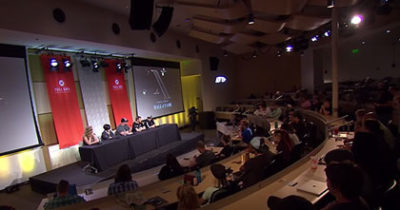How to Be an Awesome Recording Studio Employee, and More
This week was packed to the brim with exciting new music production articles and videos from around the web. We’ll be exploring what makes an excellent recording studio employee, various mixing tips to help improve your productions, and a behind the scenes look at the world-famous Capitol Studios in Los Angeles.
How to Be an Awesome Recording Studio Employee
This video by Full Sail University discusses the difference between hard skills (technical) and soft skills (social) while explaining how striking a balance between the two is critical to landing work. A panel of Full Sail graduates, now business owners, provide their input on what makes a great employee and how you can ascend the ranks of the recording studio you work for.
The Reason You Always Mix Your Bass To Quiet/Loud
It’s not very often that you get to blame a poor mix on something other than your own ability, but Black Ghost Audio explains why this is one of those unique cases. Room modes, standing waves, nodes, and anti-nodes; the culprits responsible for your low-end never translating well to other playback systems. Learn what causes these acoustic problems, and how you can deal with them.
SOS Visits the World-Famous Capitol Studios in Los Angeles
With the release of UAD’s most recent plugin, Capitol Chambers, you may be curious to learn more about Capitol Studios, the recording studio on the first floor of Capitol Tower in Los Angeles. Sound On Sound explores the history of Capitol Studios while taking a look at the gear and artists who have ventured through the iconic building.
How to Use Transient Shapers for Better Dynamics
Compressors are a common tool for taming transients, but the issue is that they’re threshold level dependent. Transient shapers are threshold level independent, meaning they’re able to shape the transients of dynamic sources like the snare track of a jazz drummer. They have more in common with the ADSR section of a synth than a compressor. Watch the full video by LANDR to learn how they work.
9 Pro Parallel Compression Tips for Vocals
Sundown Sessions is back at it again with some great mixing tips, this time covering parallel compression. Some of the tips include gating breaths, using multiple compressors, compressing a vocal double, EQing your compressed signal, de-essing your parallel signal, and more. There were several tricks mentioned in this article that I hadn’t thought to make us of before.
Mix the Most Important Instrument First
Graham Cochrane of The Recording Revolution believes that you should mix the most crucial element of your mix first. Every song is different, so the most important instrument is going to change; it could be the vocals, drums, or even guitar. The first instrument you mix is the only instrument you need to mix while soloed, which means it’s vital that you get it right, set the standard for the track, and build upwards from there.
10 Tips for Performing Live With Tech
If you’ve ever attempted to construct a live show that makes use of fancy tech, you know just how tricky it can be. MusicTech recommends traveling light, creating a live-gear list, having a backup plan, acquiring visuals, and more in this rapid-fire guide on how to make the most of your live, tech-focused sets.
Recording and Mixing Audio for Virtual Reality
According to Adam Crute of MusicTech, “Technically speaking, VR audio is binaural, in other words, a different audio signal is fed to each ear to create the perception of a three-dimensional sound field. In many senses, the stereophonic sound is binaural, but the words aren’t synonymous: stereo audio can’t recreate a complete and natural three-dimensional sound field, whereas that’s what binaural audio is all about.” Crute covers Ambisonic microphones like the Sennheiser Ambeo, DAWs that support Ambisonics like Pro Tools, Nuendo, and Cubase, as well as tools for syncing your DAW with a VR video player.
Essential DAW Mixing Organization Tips
Sean Divine offers some Logic Pro X organization tips; these concepts can be applied to other DAWs as well. He suggests that you group tracks, name tracks, utilize track icons, use track colors, use consistent sample rates for all tracks, delete unused tracks, and commit to an arrangement before mixing. Learn more about these mixing tips by watching the full video.
Charles Hoffman is a Mixing and Mastering Engineer at Black Ghost Audio. After graduating from the University of Manitoba with an English degree, Charles completed his education at Icon Collective in Los Angeles, CA.
Please note: When you buy products through links on this page, we may earn an affiliate commission.








[…] http://sonicscoop.com/2019/05/25/how-to-be-an-awesome-recording-studio-employee-and-more/ How to Be an Awesome Recording Studio Employee, and More […]